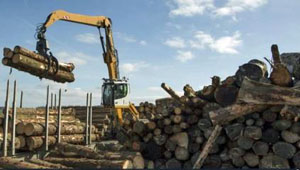New Tech Turns Abundance of Timber into Sustainable Solutions
![]() Print this Article | Send to Colleague
Print this Article | Send to Colleague
 The Hill (Washington, D.C., USA) reported Oct. 26, 2018 that thousands of products are made from working forests in the United States; the forest products industry supports 2.4 million jobs and $99 billion in payroll, yet the families and small businesses who maintain our forests are struggling with 50-year low stump prices, as reported by The Wall Street Journal. The demand for forestry products has not kept up with the vast reforestation and increased sustainability of U.S. forests, which have increased in volume by 50% since the 1950s.
The Hill (Washington, D.C., USA) reported Oct. 26, 2018 that thousands of products are made from working forests in the United States; the forest products industry supports 2.4 million jobs and $99 billion in payroll, yet the families and small businesses who maintain our forests are struggling with 50-year low stump prices, as reported by The Wall Street Journal. The demand for forestry products has not kept up with the vast reforestation and increased sustainability of U.S. forests, which have increased in volume by 50% since the 1950s.Long term, oversupply and low prices discourage reforestation and devalue rural land, where many families and communities — who often feel forgotten — already are struggling to make ends meet.
In a presidential proclamation focused on National Forest Products Week (Oct. 21-27), President Trump stated that his administration "recognize(s) that strong, healthy, and well-managed forests are vital to our nation’s economic prosperity."
Many Americans couldn't agree more.... However, more needs to be done to open new markets for our abundant, renewable resources and ensure forest landowners a reasonable return on their hard work and investment.
Currently there are limitations in what they can do with their pine and other plantation trees. As noted by OTW earlier this month, some tree plantations future in the southeast are actually in jeopardy due to an unexpected lack of demand either for pulping (the region has operations, but not necessarily dense and linked to the forest system effectively or directly) or even for use in construction,
Despite recent technological advances in biomass processing that allow the production of advanced biofuels, naturally-derived plastics, adhesives and chemicals, these products cannot be recognized under the U.S. Renewable Fuel Standard if made from forest materials.
Private-sector innovation often outpaces policies designed many years ago. In the case of emerging biotechnologies, bureaucratic lag at the U.S. Environmental Protection Agency (EPA) has stymied the growth of renewable fuels from countless biomass sources.
While EPA has drafted modernized policy, the necessary approvals for plantation trees such as southern pine, willow and hybrid poplar have been shelved for years. Some real action by EPA would be a win-win policy creating additional demand for foresters, jobs in rural communities, and environmentally beneficial fuels.
Companies that have developed technologies to convert woody biomass into ethanol and other fuels and bio-products are waiting for the EPA to deploy their technologies. These fuels are particularly promising since they are advanced, second-generation biofuels that produce significantly fewer emissions, utilize less cropland and don’t compete with our food and agriculture supply the way that corn ethanol does.
Companies in this growing space also are using forest products in ways that are significantly more efficient than traditional pulp and paper mills — which waste significant economic value by burning about 50 percent of a tree after extracting the pulp. Using the whole tree creates two times more transportation fuel than traditional processes.
This is a rare opportunity for the country: a simple regulatory fix could remove a major roadblock to American innovation and revitalization. Opening privately-owned forests — not taxpayer-owned forests — to biofuels and bio-based additive production would create good-paying rural jobs, a claimed priority of the Trump administration.
Some believe there is a path for each state to be energy independent by utilizing its own forestry and biomass resources. The goal would be to build smaller facilities, regionally throughout each state, closer to feedstock sources and convert any type of biomass into ethanol and drop-in replacements of transportation fuels. This strategy would increase the number of manufacturing jobs, enable higher wages and provide a robust educational environment to train and enable rural Americans to thrive in their communities.
By building facilities in each state to utilize the forestry and biomass from each state, we can reduce the need for large-scale logistics and move products efficiently by local carriers or small intrastate pipelines.
The U.S. forestry industry will not be transformed overnight, but the abundance of this renewable resource is a golden opportunity for innovation, which our industry and government should fully embrace.


